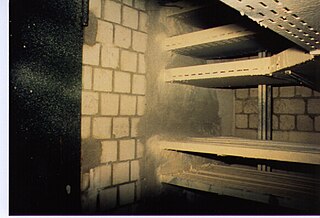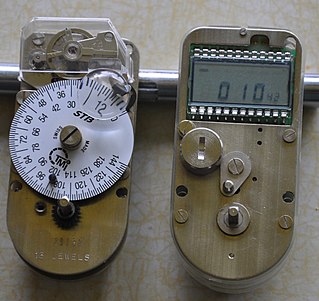
Locksmithing is the science and art of making and defeating locks. Locksmithing is a traditional trade and in many countries requires completion of an apprenticeship. The level of formal education legally required varies from country to country from none at all, to a simple training certificate awarded by an employer, to a full diploma from an engineering college, in addition to time spent working as an apprentice.

Linus Yale Jr. was an American mechanical engineer, manufacturer, and co-founder with millionaire Henry R. Towne of the Yale Lock Company, which became the premier manufacturer of locks in the United States. He was the country's leading expert on bank locks and its most important maker. By the early 20th century, about three-quarter of all banks in America used his bank locks. He is best remembered for his inventions of locks, especially the cylinder lock, and his basic lock design is still widely distributed today, and constitutes a majority of personal locks and safes.

A safe is a secure lockable enclosure used for securing valuable objects against theft or fire. A safe is usually a hollow cuboid or cylinder, with one face being removable or hinged to form a door. The body and door may be cast from metal or formed out of plastic through blow molding. Bank teller safes typically are secured to the counter, have a slit opening for dropping valuables into the safe without opening it, and a time-delay combination lock to foil thieves. One significant distinction between types of safes is whether the safe is secured to a wall or structure or if it can be moved around.

A structural insulated panel, or structural insulating panel, (SIP), is a form of sandwich panel used in the construction industry.

Safe-cracking is the process of opening a safe without either the combination or the key.

The United States Bullion Depository, often known as Fort Knox, is a fortified vault building located next to the United States Army post of Fort Knox, Kentucky. It is operated by the United States Department of the Treasury. The vault is used to store a large portion of the United States' gold reserves as well as other precious items belonging to or in custody of the federal government. It currently holds roughly 147 million troy ounces of gold bullion, a little over half the total gold presently held by the federal government. The United States Mint Police protects the depository.

Vinyl siding is plastic exterior siding for houses and small apartment buildings, used for decoration and weatherproofing, imitating wood clapboard, batten board and batten or shakes, and used instead of other materials such as aluminum or fiber cement siding. It is an engineered product, manufactured primarily from polyvinyl chloride (PVC) resin. In the UK and New Zealand a similar material is known as uPVC weatherboarding.

Fireproofing is rendering something resistant to fire, or incombustible; or material for use in making anything fire-proof. It is a passive fire protection measure. "Fireproof" or "fireproofing" can be used as a noun, verb or adjective; it may be hyphenated ("fire-proof").

Precast concrete is a construction product produced by casting concrete in a reusable mold or "form" which is then cured in a controlled environment, transported to the construction site and maneuvered into place; examples include precast beams, and wall panels for tilt up construction. In contrast, cast-in-place concrete is poured into site-specific forms and cured on site.

Passive fire protection (PFP) is components or systems of a building or structure that slows or impedes the spread of the effects of fire or smoke without system activation, and usually without movement. Examples of passive systems include floor-ceilings and roofs, fire doors, windows, and wall assemblies, fire-resistant coatings, and other fire and smoke control assemblies. Passive fire protection systems can include active components such as fire dampers.

A time lock is a part of a locking mechanism commonly found in bank vaults and other high-security containers. The time lock is a timer designed to prevent the opening of the safe or vault until it reaches the preset time, even if the correct lock combination(s) are employed.

The term door security or door security gate may refer to any of a range of measures used to strengthen doors against door breaching, ram-raiding and lock picking, and prevent crimes such as burglary and home invasions. Door security is used in commercial and government buildings, as well as in residential settings.

A gun safe is a safe designed for storing one or more firearms and/or ammunitions. Gun safes are primarily used to prevent access by unauthorized or unqualified persons, for burglary protection and, in more capable safes, to protect the contents from damage by flood, fire or other natural disasters.

The Mosler Safe Company was an American multinational manufacturer of security equipment specializing in safes and bank vaults. In 2001, the company was acquired by Diebold Inc. after going bankrupt.

A locker is a small, usually narrow storage compartment. They are commonly found in dedicated cabinets, very often in large numbers, in various public places such as locker rooms, workplaces, schools, transport hubs and the like. They vary in size, purpose, construction, and security.
Fichet-Bauche is a brand of safes and vaults with its origin in France. It specializes in products which offer certified burglary protection and/or fire protection. The brand is widely sold and marketed in France, Spain, Portugal, Italy and French speaking parts of Africa. Fichet-Bauche is a brand owned by OpenGate Capital.

VingCard Elsafe, whose origin was in Moss, Norway, is an international producer of hotel locking systems, electronic in-room safes and energy management systems. After inventing the first mechanical hole card operated lock in 1976, VingCard was acquired in 1994 by ASSA ABLOY, and merged with the electronic safe producer Elsafe to form VingCard Elsafe in 2006. Since 2015 VingCard Elsafe is not an operating company, but a product brand within ASSA ABLOY Global Solutions.
„European Certification Body“ (ECB) is a since 7 July 1992 accredited and neutral certification body for physical security products. It certifies according to – without any national additional requirements. ECB issues the ECB•S certification mark.
EN 16034 refers to a set of European standards which specify the technical performance characteristics for fire resisting and/or smoke control products, or better known in common language as fire/smoke doors or fire/smoke proof doors. Compliance with this standard requires to fulfill the requirements of the Construction Product Regulation for construction products, which are placed on the EU market with the intention to become permanent parts of a construction.
This is a glossary of locksmithing terms.




















